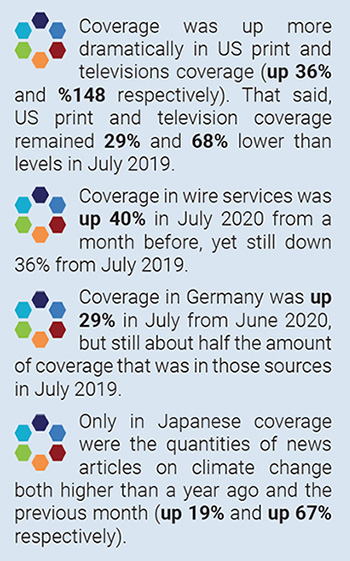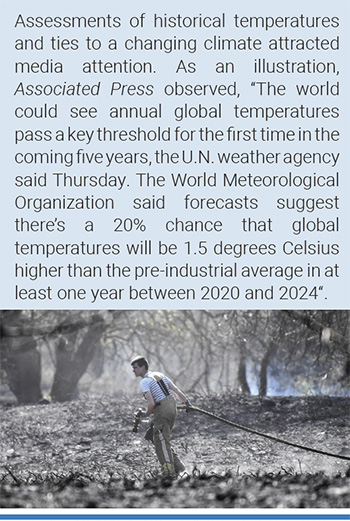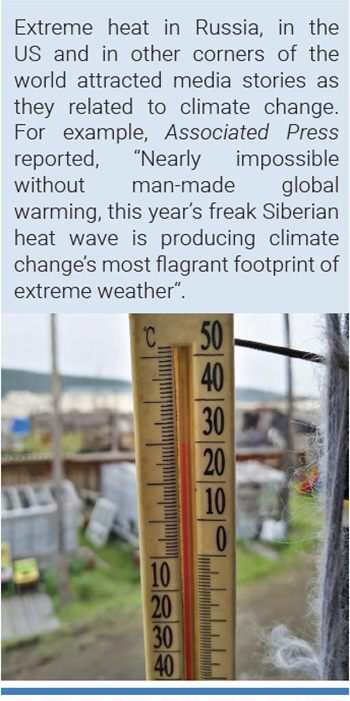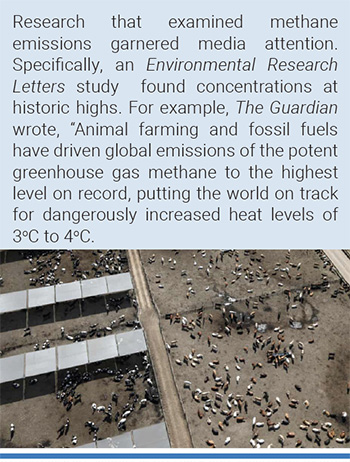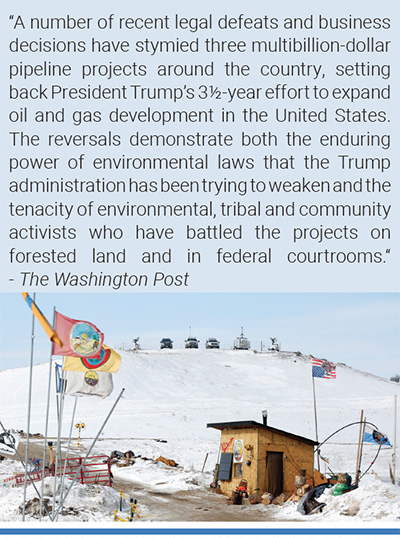Monthly Summaries
Issue 43, July 2020
[DOI]

Floodwaters in Bogura, Bangladesh, near the Brahmaputra River, in mid-July. Photo: Mohammad Ponir Hossain/Reuters.

July 2020 has seen a 5% uptick in media coverage of climate change or global warming, but still at levels 37% lower than a year ago (July 2019). While that represents somewhat of a rebound, media coverage of climate change or global warming remained at lower levels than the quantity of coverage at the start of 2020 as well as during the previous Northern Hemisphere summer of 2019 (see Figure 1). Regionally, the changes in quantity of ongoing stream of stories in July as compared to June 2020 was mixed: the number of articles in Latin American and African sources were up slightly (+0.5% and +1.5% respectively), while up more in North American, Asian and Middle Eastern sources (+9%, +12% and +31% respectively); meanwhile the amount of climate change coverage was down slightly in Europe (-3.5%) while down a bit more in Oceania (-8%).
Figure 1 shows trends in newspaper media coverage at the global scale – organized into seven geographical regions around the world – from January 2004 through July 2020.

Figure 1. Newspaper media coverage of climate change or global warming in print sources in seven different regions around the world, from January 2004 through July 2020.
At the country level, media coverage of climate change or global warming has also seen mixed trends in July 2020 compared to June 2020. For examples, coverage was up more dramatically in United States (US) print and televisions coverage (up 36% and %148 respectively). That said, US print and television coverage remained 29% and 68% lower than levels in July 2019. Elsewhere, coverage in The Associated Press, Agence France Presse, The Canadian Press, and United Press International wire services was up 40% in July 2020 from a month before, yet still down 36% from July 2019. Meanwhile, coverage in Süddeutsche Zeitung and Die Tageszeitung in Germany was up 29% in July from June 2020, but still about half the amount of coverage that was in those sources in July 2019 (see Figure 2). Also at the country level, only in Japanese coverage – Asahi Shimbun, Yomiuri Shimbun, and Mainichi Shimbun – were the quantities of news articles on climate change or global warming both higher than a year ago (July 2019) and the previous month (June 2020) (up 19% and up 67% respectively). In all other countries monitored (in addition to the aforementioned coverage in the US, Germany and Japan) through the Media and Climate Change Observatory (MeCCO) – Australia, Canada, India, New Zealand, Norway, Russia, Spain, Sweden and the United Kingdom (UK) – coverage remained at lower levels in July 2020 as compared to July 2019 (see our MeCCO website for more details.

Figure 2. German newspaper media coverage of climate change "Klimawandel" or global warming "Globale Erwärmung" in Süddeutsche Zeitung and Die Tageszeitung from January 2004 through July 2020.
|
Moving to the content of coverage, in July ecological and meteorological themes drove media coverage of climate change or global warming. For instance, assessments of historical temperatures and ties to a changing climate attracted media attention. As an illustration, Associated Press reporters Nadine Achoui-Lesage and Frank Jordans observed, “The world could see annual global temperatures pass a key threshold for the first time in the coming five years, the U.N. weather agency said Thursday. The World Meteorological Organization said forecasts suggest there’s a 20% chance that global temperatures will be 1.5 degrees Celsius (2.7 Fahrenheit) higher than the pre-industrial average in at least one year between 2020 and 2024. The 1.5 C mark is the level countries agreed to cap global warming at in the 2015 Paris accord. While a new annual high might be followed by several years with lower average temperatures, breaking that threshold would be seen as further evidence that international efforts to curb climate change aren’t working”. Meanwhile, CNN journalist Amy Woodyatt reported, “In 2020, the Arctic is likely to have warmed by more than twice the global mean, and many parts of South America, southern Africa and Australia are likely to be dryer than in the recent past, the WMO said. There is a 70% chance that one or more months during the next five years will be at least 1.5 degrees Celsius warmer than pre-industrial levels, the WMO assessment said. In the coming five years, almost all regions are likely to be warmer than the recent past, scientists warned. Over 2020-2024, eastern parts of South America are likely to be dryer, high latitude regions and the Sahel are likely to be wetter, and the northern North Atlantic region could have stronger westerly winds, which could lead to more storms in western Europe”.
Further into July, extreme heat in Russia, in the USA and in other corners of the world attracted media stories as they related to climate change. For example, Associated Press journalist Seth Borenstein reported, “Nearly impossible without man-made global warming, this year’s freak Siberian heat wave is producing climate change’s most flagrant footprint of extreme weather, a new flash study says. International scientists released a study Wednesday that found the greenhouse effect multiplied the chance of the region’s prolonged heat by at least 600 times, and maybe tens of thousands of times. In the study, which has not yet gone through peer review, the team looked at Siberia from January to June, including a day that hit 100 degrees (38 degrees Celsius) for a new Arctic record. Scientists from the United Kingdom, Russia, France, Netherlands, Germany and Switzerland used 70 climate models running thousands of complex simulations comparing current conditions to a world without man-made warming from the burning of coal, oil and gas. They found that without climate change the type of prolonged heat that hit Siberia would happen once in 80,000 years, “effectively impossible without human influence,” said study lead author Andrew Ciavarella, a scientist at the UK Met Office”.
In this April 22, 2020 photo, firefighters works at a forest fire in a burned national park at the Dutch-German border near Herkenbosch, Netherlands. Photo: Martin Meissner/AP. |
Pivoting to extreme events, the comparatively active Atlantic hurricane season starting in May 2020 generated journalists’ time and attention.For example, Washington Post journalists Matthew Cappucci, Andrew Freedman and Jason Samenow wrote, “Hanna, the first hurricane of the 2020 Atlantic season, is barging into South Texas unleashing wind gusts over 100 mph, torrential rain, and storm surge inundation along the coast. The storm officially made landfall at 5:00 p.m. central over Padre Island, Texas. It comes as Pacific storm Hurricane Douglas bears down on Hawaii and as two other systems whirl out over the Atlantic during what it is expected to be an abnormally active season. A record number of storms have already occurred to this point... As a whole, the tropics are blistering with activity, in stark contrast to the ominous quiescent that enveloped the Atlantic Basin just one week ago. Hanna’s formation on Thursday evening demolished the previous record for a season’s earliest “H” storm — formerly held by Tropical Storm Harvey, which formed on Aug. 3, 2005 — as the latest domino to topple in a record-busy start to hurricane season. The season has already featured the earliest “C,” “E,” “F” and “G” storms on record — Cristobal, Edouard, Fay and Gonzalo. A season’s eighth named storm typically doesn’t develop until closer to late September. As the season’s first hurricane, Hanna comes about two weeks early. The average first hurricane in the Atlantic basin forms around Aug. 10. Hanna’s central pressure, which dropped to at least 973 millibars, marks the lowest pressure for a storm in the Gulf of Mexico during July since Hurricane Alex in 2010. The lower the pressure the strong the storm in most cases. Atmospheric scientists had been warning that the 2020 Atlantic hurricane season could be a hectic one, with large-scale atmospheric circulations and patterns, like a developing La Niña, favoring an increased number of storms. Meanwhile, ultra-warm waters could help make those that form more intense and wetter, with a greater potential for storms to undergo rapid intensification. The warming seas are largely a symptom of human-induced climate change”.
In later July, flooding in Asia drew media attention as it related to climate change and global warming links.For example, journalists Somini Sengupta and Julfikar Ali Manik reported, “torrential rains have submerged at least a quarter of Bangladesh, washing away the few things that count as assets for some of the world’s poorest people — their goats and chickens, houses of mud and tin, sacks of rice stored for the lean season. It is the latest calamity to strike the delta nation of 165 million people. Only two months ago, a cyclone pummeled the country’s southwest. Along the coast, a rising sea has swallowed entire villages. And while it’s too soon to ascertain what role climate change has played in these latest floods, Bangladesh is already witnessing a pattern of more severe and more frequent river flooding than in the past along the mighty Brahmaputra River, scientists say, and that is projected to worsen in the years ahead as climate change intensifies the rains... The Brahmaputra is a fearsome, shape-shifting 2,400-mile river that erupts from the Tibetan Himalayas and spills into northeastern India before merging with the Ganges in Bangladesh and emptying into the Bay of Bengal. It irrigates vast areas of farmland but it’s also unpredictable, often swallowing the islands that form within it... Climate change, too, is altering its fate — and that of the people who live along its banks”. Meanwhile, Guardian journalist Graham Readfearn noted, “The combined impacts of human-caused sea level rise, storm surges and high tides could expose an extra 23 million people to coastal flooding within the next 30 years, even with relatively ambitious cuts to greenhouse gas emissions”.
This June 21, 2020 photo shows an outdoor thermometer indicating 30 Celsius (86 Fahrenheit) around 11 p.m in Verkhoyansk, Sakha Republic, about 4,660 kilometers (2,900 miles) northeast of Moscow, Russia. Photo: Olga Burtseva via AP. |
In July, there were also many media stories about scientific research and findings about aspects of climate change or global warming. To begin, in early July a research output from Nature found that agricultural practices have the potential to pull greenhouse gases from the atmosphere. This sparked media attention. For example, journalist Damian Carrington from The Guardian reported, “Spreading rock dust on farmland could suck billions of tonnes of carbon dioxide from the air every year, according to the first detailed global analysis of the technique. The chemical reactions that degrade the rock particles lock the greenhouse gas into carbonates within months, and some scientists say this approach may be the best near-term way of removing CO2 from the atmosphere. The researchers are clear that cutting the fossil fuel burning that releases CO2 is the most important action needed to tackle the climate emergency. But climate scientists also agree that, in addition, massive amounts of CO2 need to be removed from the air to meet the Paris agreement goals of keeping global temperature rise below 2C. The rock dust approach, called enhanced rock weathering (ERW), has several advantages, the researchers say. First, many farmers already add limestone dust to soils to reduce acidification, and adding other rock dust improves fertility and crop yields, meaning application could be routine and desirable. Basalt is the best rock for capturing CO2, and many mines already produce dust as a byproduct, so stockpiles already exist. The researchers also found that the world’s biggest polluters, China, the US and India, have the greatest potential for ERW, as they have large areas of cropland and relatively warm weather, which speeds up the chemical reactions. The analysis, published in the journal Nature, estimates that treating about half of farmland could capture 2bn tonnes of CO2 each year, equivalent to the combined emissions of Germany and Japan. The cost depends on local labour rates and varies from $80 per tonne in India to $160 in the US, and is in line with the $100-150 carbon price forecast by the World Bank for 2050, the date by which emissions must reach net zero to avoid catastrophic climate breakdown”.
Further into July, research that examined methane emissions garnered media attention. Specifically, an Environmental Research Letters study found concentrations at historic highs. For example, journalist Jonathan Watts from The Guardian wrote, “Animal farming and fossil fuels have driven global emissions of the potent greenhouse gas methane to the highest level on record, putting the world on track for dangerously increased heat levels of 3C to 4C. Since 2000 discharges of the odourless, colourless gas have risen by more than 50m tonnes a year, equivalent to 350m cars or double the total emissions of Germany or France, according to the latest Methane Budget study by a global team of scientists. The findings... show that more than half of the methane in the atmosphere now comes from human sources. Of this share, ranching, agriculture and landfills account for about two-thirds, while the fossil fuel industry, composed of oil, gas and coal, makes up the rest. Methane is second only to carbon dioxide in its contribution to global heating; the gas is released in much smaller quantities but is 28 times more powerful at trapping warmth over a 100-year span. In 2017, the most recent year for which data is available, the planet’s atmosphere absorbed almost 600m tonnes of methane, up 9% from the early years of the century when concentrations were relatively stable”. As another example, New York Times journalist Hiroko Tabuchi noted, “Curbing methane emissions will require better plugging leaks and other fugitive emissions from oil and gas infrastructure, like wells and pipelines, which are a major source of methane emissions, the scientists said. It will also require an overhaul of agriculture, especially cattle and rice farming, two large sources of methane emissions. A big question mark is the contribution of natural sources of methane emissions, like wetlands, mud volcanoes and permafrost. Natural methane emissions have been relatively unchanged from 2000-17, albeit with large uncertainties. There are fears, for example, that thawing permafrost in the Arctic could start releasing large quantities of methane into the atmosphere, further accelerating climate change. For now, scientists have found little evidence of increasing methane emissions in the Arctic, though they warn that could change as warming intensifies. Scientists have warned that the Arctic region is warming at more than twice the rate of the rest of the planet. “The key message is that methane concentrations and emissions are still rising, and we know the main cause,” said Marielle Saunois, a scientist at the Laboratory for Climate and Environmental Sciences in France, and a member of the research team. “This is not the right path”.
In addition, in July, a Nature Climate Change study of sea ice loss caused by global warming attracted media stories. For example, BBC journalists Helen Briggs and Victoria Gill reported, “Polar bears will be wiped out by the end of the century unless more is done to tackle climate change, a study predicts. Scientists say some populations have already reached their survival limits as the Arctic sea ice shrinks. The carnivores rely on the sea ice of the Arctic Ocean to hunt for seals. As the ice breaks up, the animals are forced to roam for long distances or on to shore, where they struggle to find food and feed their cubs”. As another example, journalist Drew Kann from CNN wrote, “For many people, there is one animal that comes to mind when they think of creatures threatened by climate change: the polar bear. In recent years, images of emaciated bears searching desperately for food have made the Arctic's apex predator the poster child for the effects of global warming. Now, as the planet continues to warm rapidly, a new study brings another dire warning: If humans fail to reduce greenhouse gas emissions, most populations of the iconic species could struggle to survive beyond 2100. Already, some populations have likely crossed key thresholds that will make their survival difficult, and perhaps impossible...”
A cattle ranch in California. In 2017 the Earth’s atmosphere absorbed almost 600m tons of methane from all sources, up 9% from the early years of the century. Photo: Lucy Nicholson/Reuters. |
July also was a month where political and economic media coverage of climate change or global warming was evident. In particular, stories of pipeline pressures and conflicts in North America – relating to climate change pressures – shaped media narratives. For example, early in the month Washington Post journalists Juliet Eilperin, Steven Mufson and Brady Dennis wrote, “A number of recent legal defeats and business decisions have stymied three multibillion-dollar pipeline projects around the country, setting back President Trump’s 3½-year effort to expand oil and gas development in the United States. The reversals demonstrate both the enduring power of environmental laws that the Trump administration has been trying to weaken and the tenacity of environmental, tribal and community activists who have battled the projects on forested land and in federal courtrooms. In a surprise decision Monday, a federal judge ruled that the Dakota Access pipeline — which Trump approved within a month of taking office — must be shut down by Aug. 5, saying federal officials failed to carry out a complete analysis of its environmental impacts. The day before, two energy companies behind the controversial, 600-mile Atlantic Coast Pipeline abandoned their six-year bid to build it, saying the $8 billion project has become too expensive and faces an uncertain regulatory environment. And an April decision by a federal judge in Montana dealt a blow to the Keystone XL pipeline and raised questions about whether the U.S. Army Corps of Engineers will have to conduct more extensive environmental reviews for other projects”.
Also in the realm of political and economic stories about climate change, attention was paid to continued investments in offshore wind energy as a low-cost and climate-friendly technological innovate proliferating. A new report from the High Level Panel for Sustainable Ocean Economy illustrated these trends. Among global coverage, journalist Jillian Ambrose from The Guardian reported, “Global offshore wind investment more than quadrupled in the first half of the year even as the coronavirus pandemic triggered an unprecedented economic shock. A report has found that investors gave the greenlight to 28 new offshore windfarms worth a total of $35bn (£28bn) this year, four times more than in the first half of 2019 and well above the total for last year as a whole. The biggest half-year tally for offshore wind investment more than made up for a slowdown in investment for onshore wind and solar farm projects after the outbreak of Covid-19, according to the report by Bloomberg NEF (BNEF)”. Furthermore, CNN reporter Hazel Pfeifer noted, “Every dollar invested in a sustainable ocean economy can yield at least five times the return in benefits, according to a new report commissioned by the High Level Panel for a Sustainable Ocean Economy. As many countries roll out bailout packages to counter the impact of the Covid-19 pandemic, the report says investment in these four key ocean intervention areas could help aid economic recovery both now and in the future: Conservation and restoration of mangroves, decarbonization of the shipping industry, scaling up offshore wind production, and increasing sustainable protein from the ocean”.
Police vehicles idle on the outskirts of the opposition camp fighting the Dakota Access oil pipeline near Cannon Ball, ND. Photo: Terray Sylvester/Reuters. |
Especially in the US in July, numerous articles and editorials questioned US President Donald Trump’s efforts to protect the environment and to combat climate change. For example, in a piece entitled ‘Trump’s continued disregard for the environment and climate change poses a mortal threat’, the Editorial Board of The Los Angeles Times wrote, “It’s fitting that President Trump invoked an interstate highway expansion in Atlanta last week to announce final rules that, if they survive the inevitable legal challenges, will undermine one of the nation’s bedrock environmental laws, the National Environmental Policy Act. American voters face a fork in their own road this November — stay on the Trump expressway to environmental degradation and catastrophic climate change, or shift to the road, bumpy as it may be, to a cleaner environment and more sustainable future of wind, solar and other energy sources that do not involve burning fossil fuels. The COVID-19 pandemic understandably has seized the nation’s attention, but that hasn’t lessened the risk we all face from air and water pollution and carbon-fed global warming. Trump has unabashedly sought to dismantle federal regulatory structures to speed up construction projects while forging a national energy plan based on producing and burning fossil fuels. His embrace of the oil, gas and coal industries defies the global scientific consensus that burning fossil fuels emits greenhouse gases that make the Earth less habitable by warming the atmosphere, feeding stronger and more frequent storms, triggering devastating droughts that propel human migration, and pushing up sea levels so that they encroach on cities and other human settlements. In fact, the National Oceanic and Atmospheric Administration reported last week that unusually high tides led to record flooding among one-quarter of Atlantic and Gulf Coast communities where the agency maintains tide gauges. Climate change is no dystopian vision of the future; it is here. Trump’s efforts to eviscerate regulatory oversight of the environment is rooted in his belief that regulations are for the most part unnecessary hurdles to economic progress. He bewails the amount of time it takes for projects to clear environmental reviews and related court challenges, adding what, in his mind, are unnecessary costs and delays. To be honest, he may have something there. NEPA came into being five decades ago — signed into law by President Nixon — and it’s not out of line to suspect that there are places where the law and the regulations that arose from it could use some reasonable revising. But Trump and his industry-connected advisors are not the ones to trust with such a task”.
At the end of July – as the count went below 100 days before the next US Presidential election – stories of President Trump’s time to a next popular vote as it related to a changing climate abounded. For instance, Guardian journalist Emily Holden wrote, “The world will be watching the US presidential election on Tuesday 3 November, but just 24 hours later is another hugely consequential news event when the US will formally leave the Paris climate agreement. The Trump administration set the withdrawal in motion with a letter to the UN, and, in a coincidence of timing, the US will exit the day after the election, joining Iran and Turkey as the only major countries not to participate in the agreement”.
Finally, in July cultural themes also wove through many climate change or global warming stories. To illustrate, an influential opinion piece by journalist Farhaad Manjoo on rethinking transport punctuated the cultural imaginary in The New York Times.
Thanks for your ongoing interest in the work we do through the Media and Climate Change Observatory (MeCCO). We remain committed to updating our 23 open-source datasets, 13 country and seven regional profiles among global newspaper, television and radio assessments for you. To help us continue this work, please give what you can to https://giving.cu.edu/fund/media-and-climate-change-observatory-mecco.

